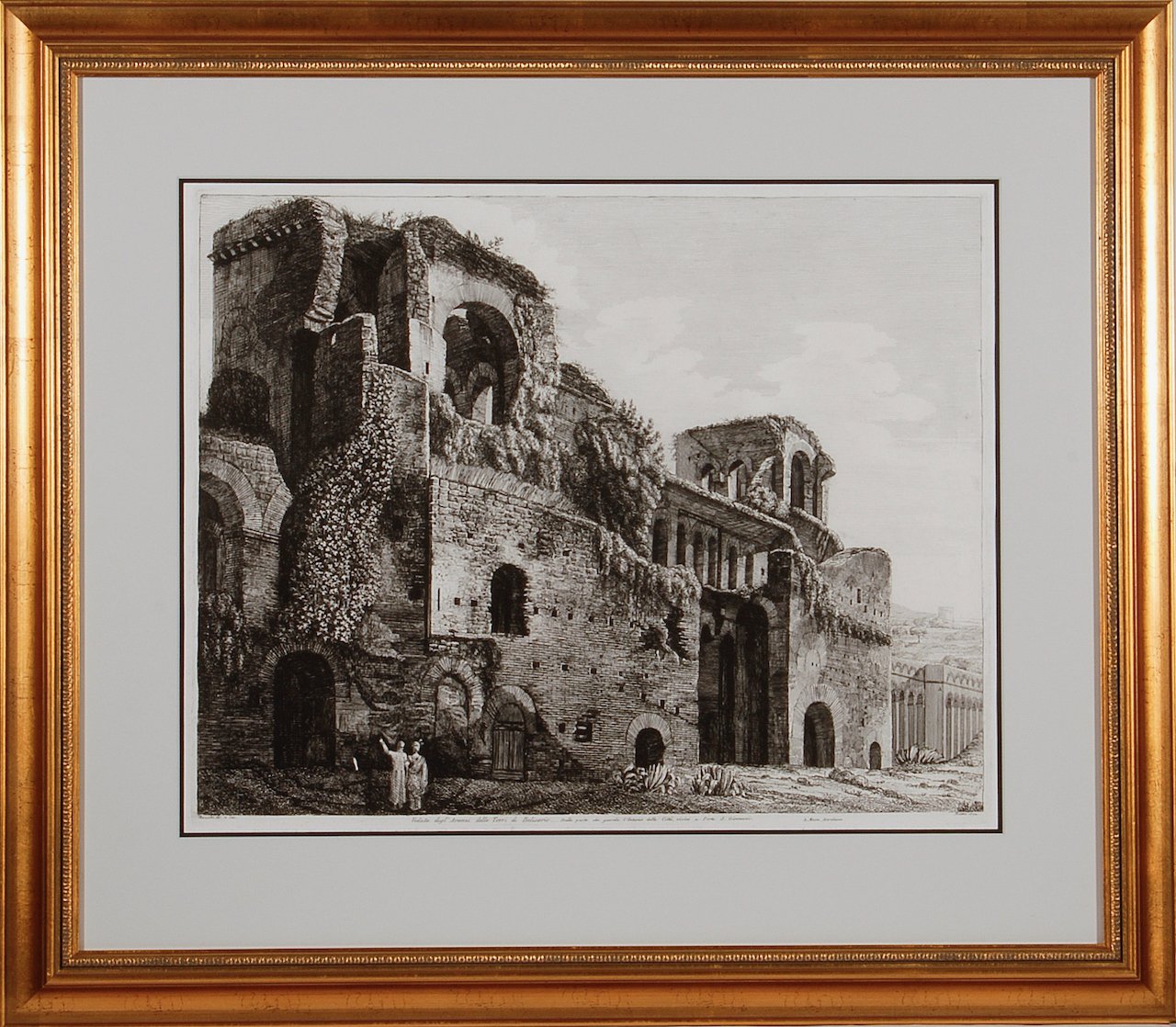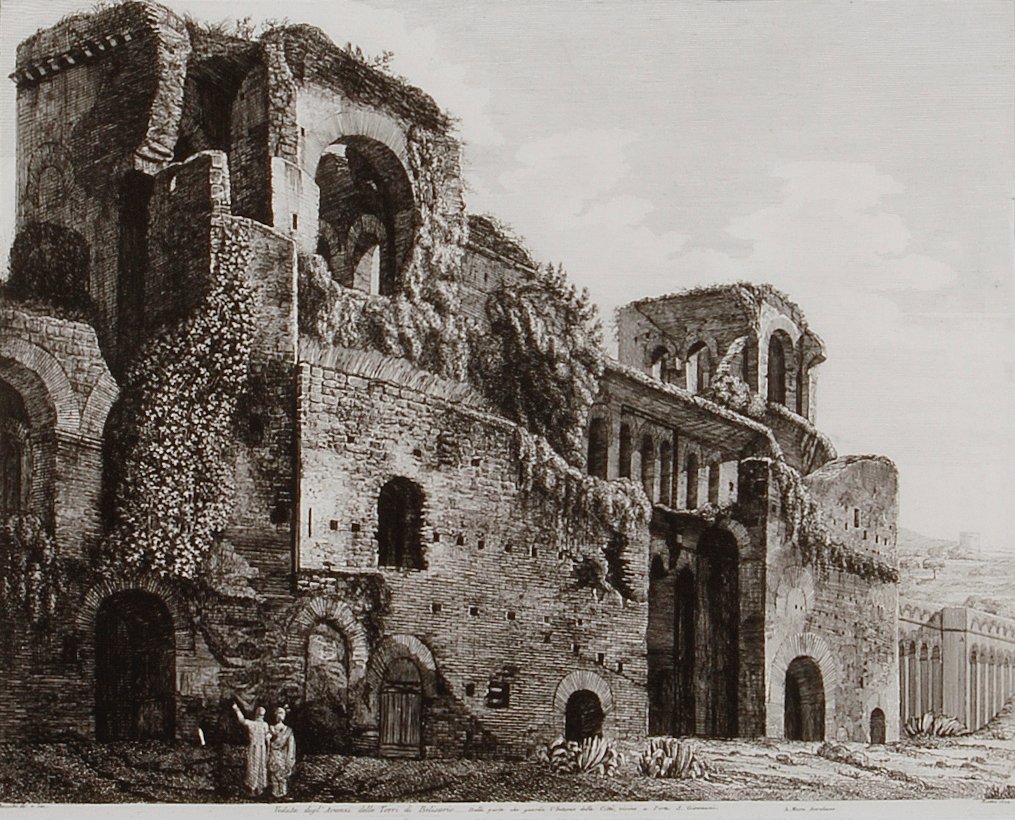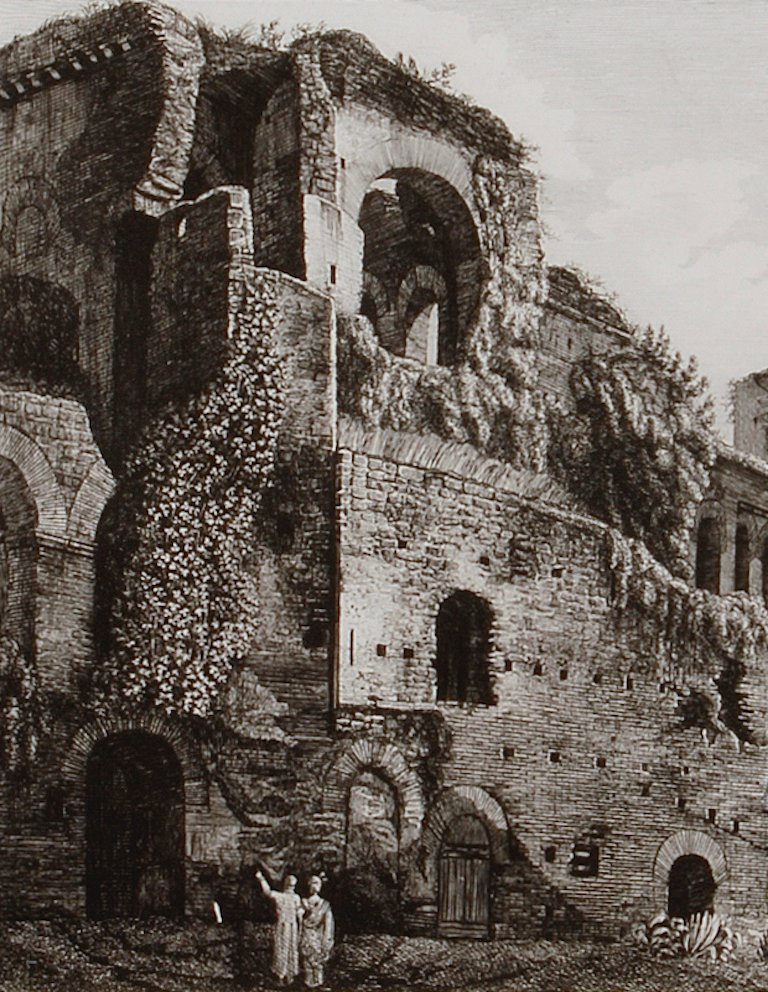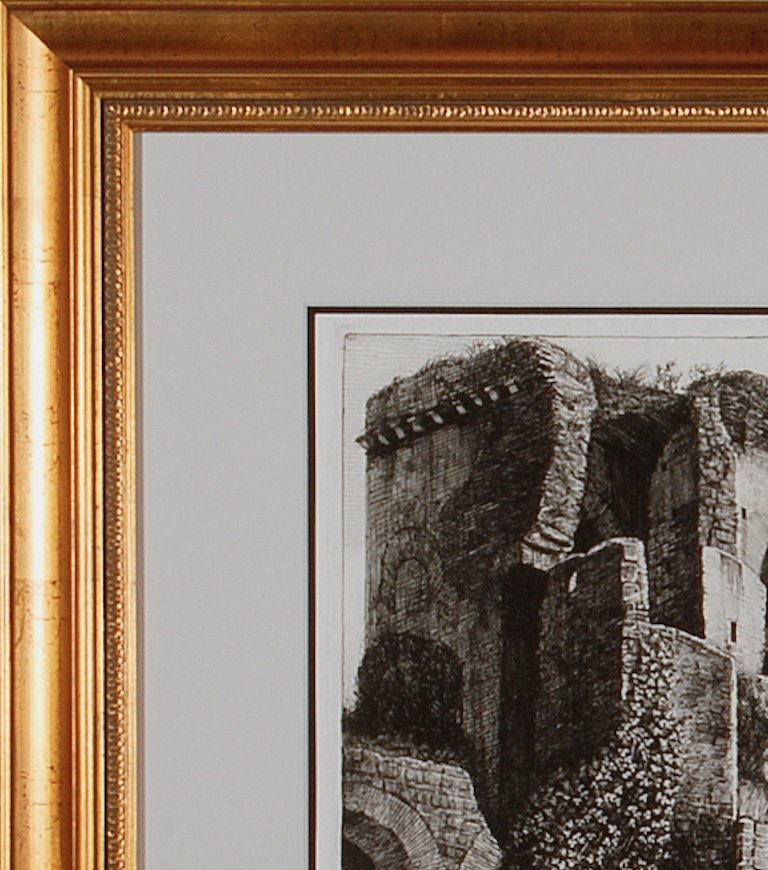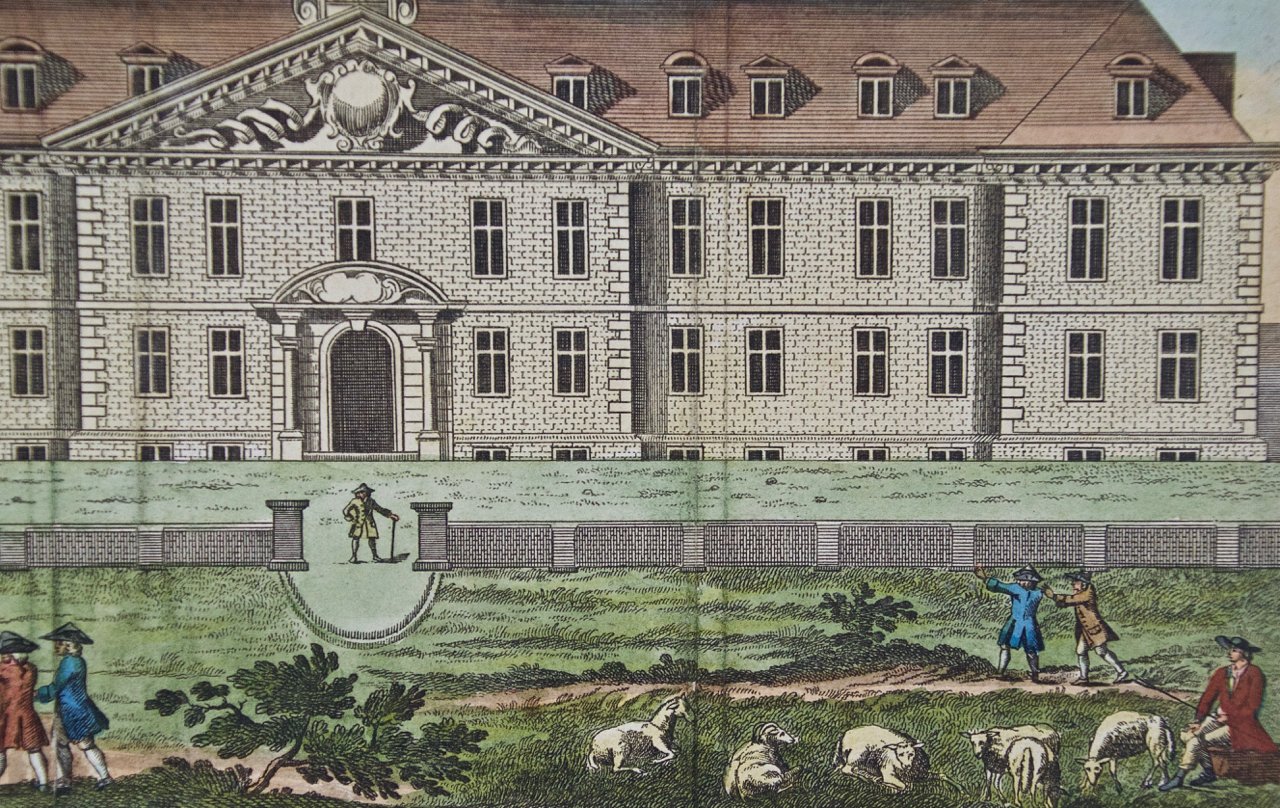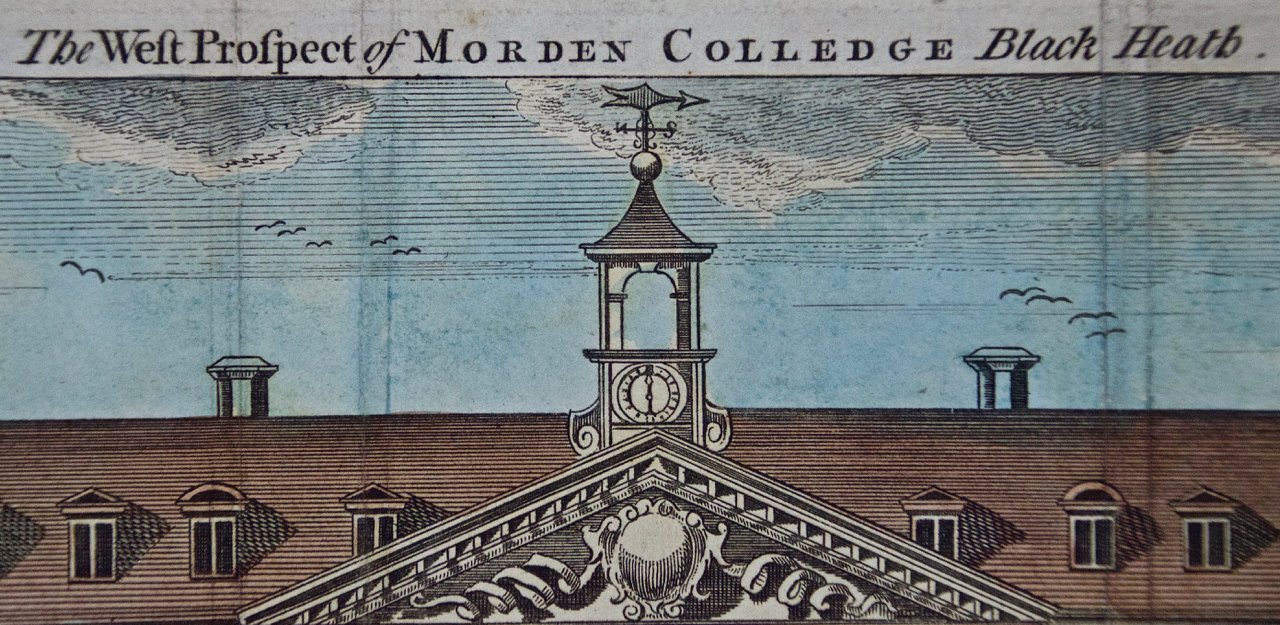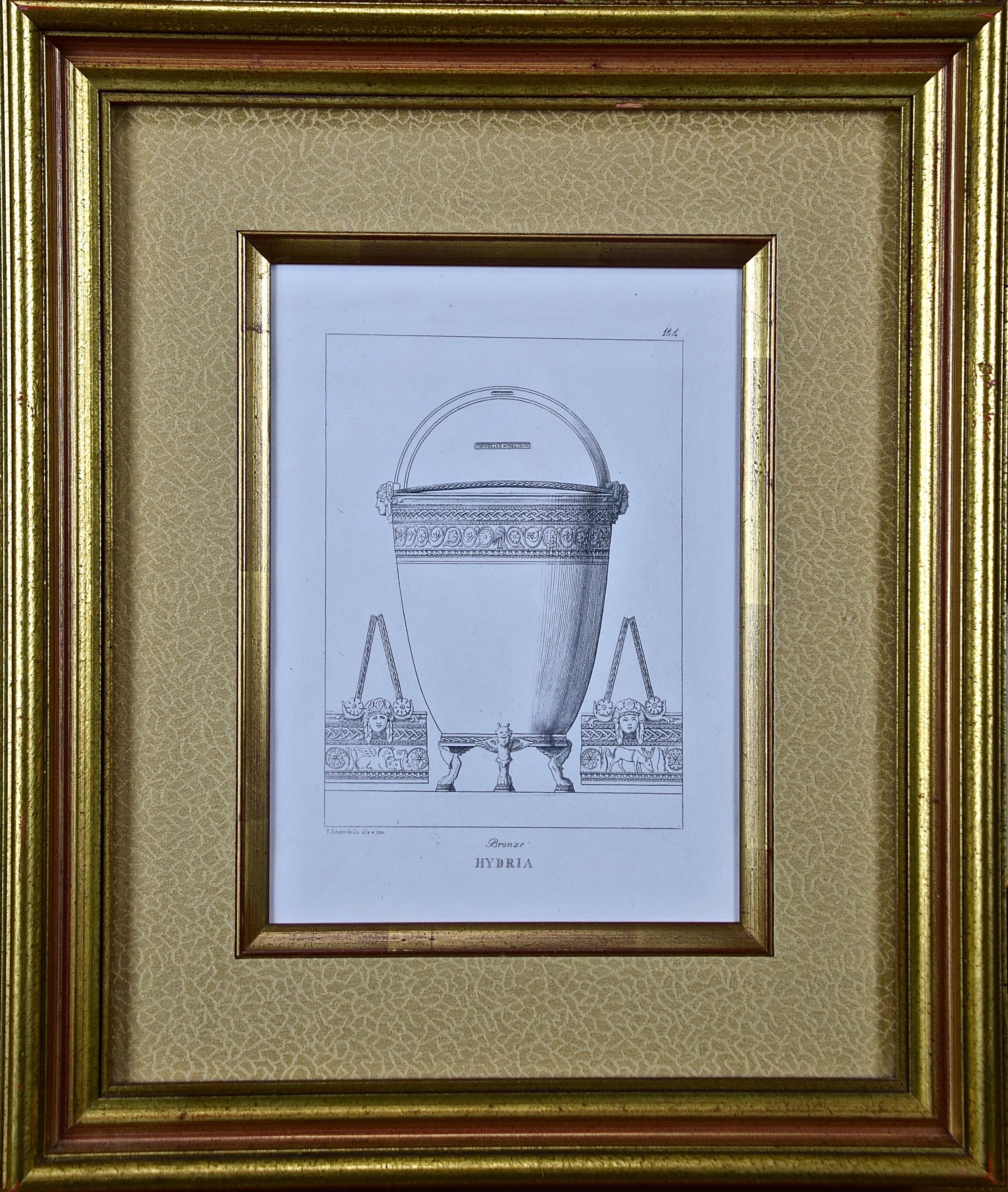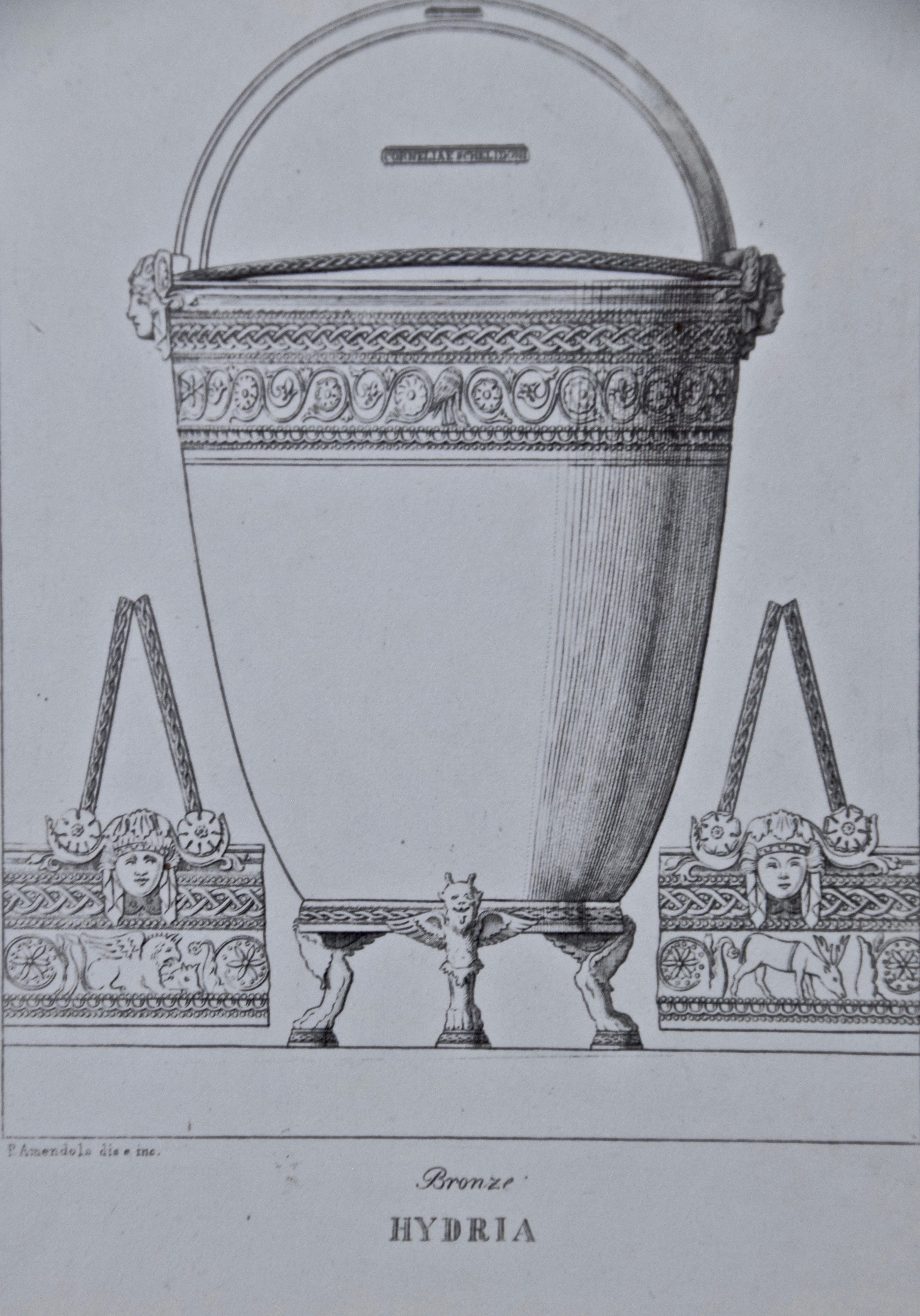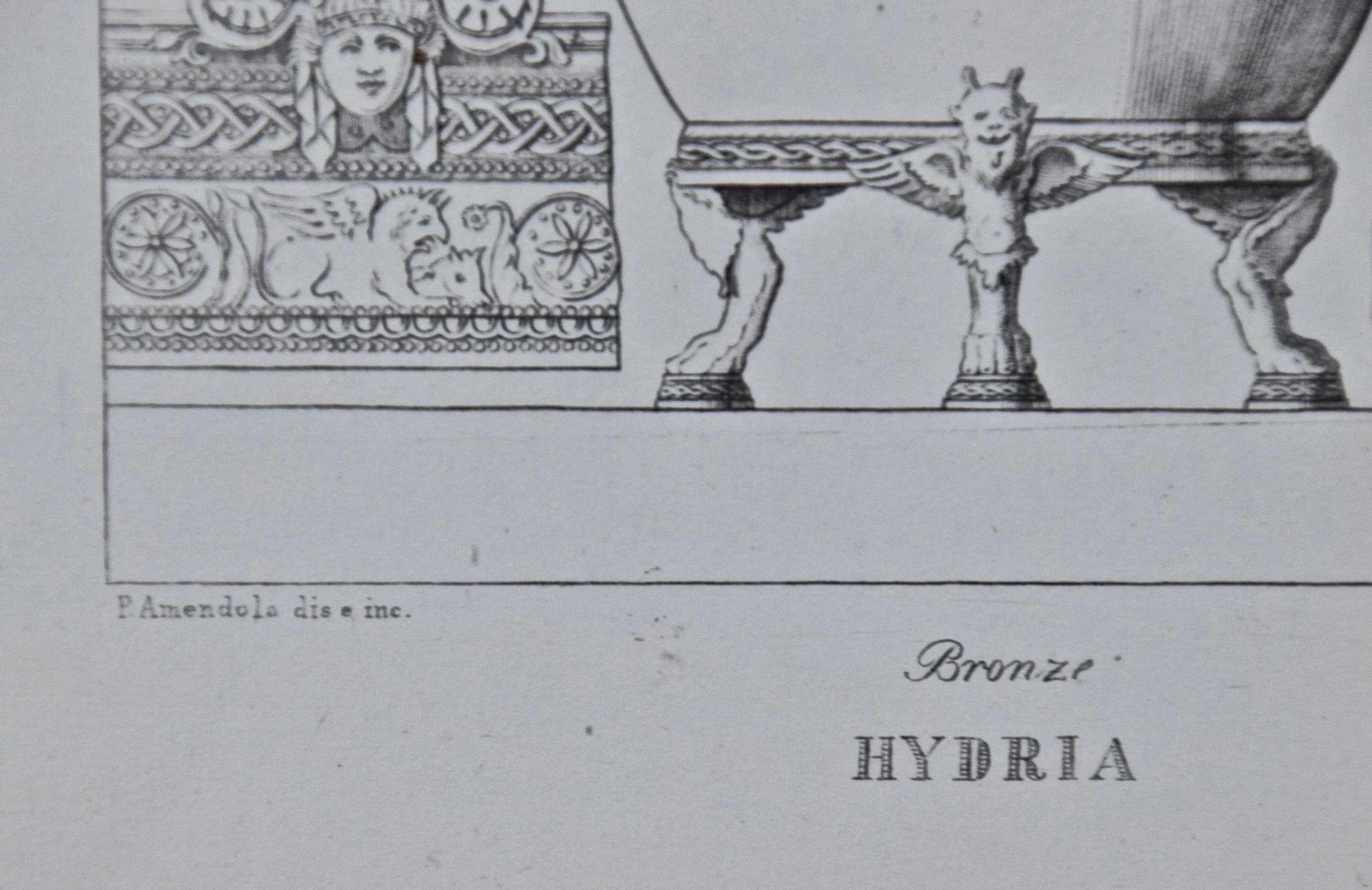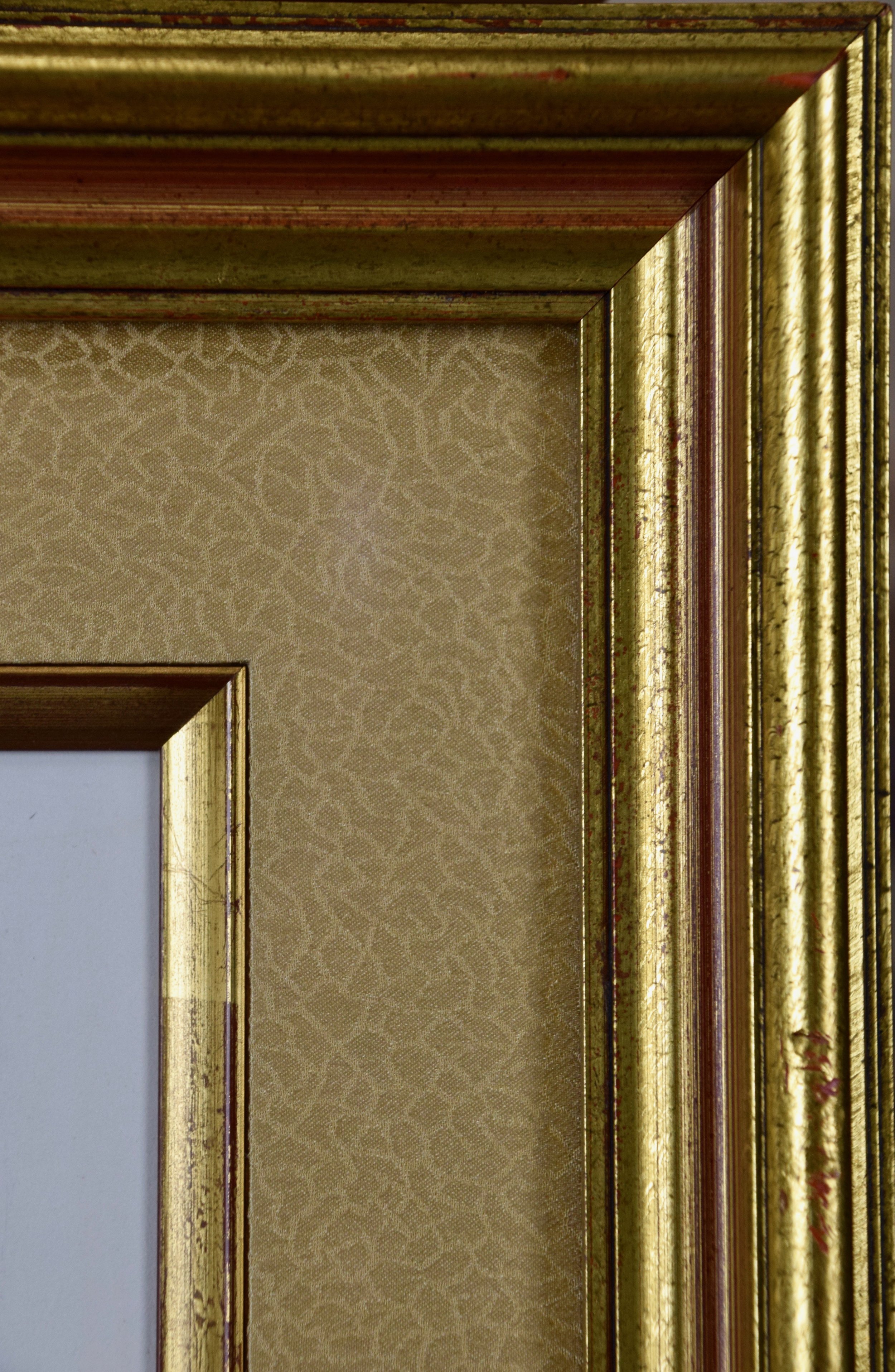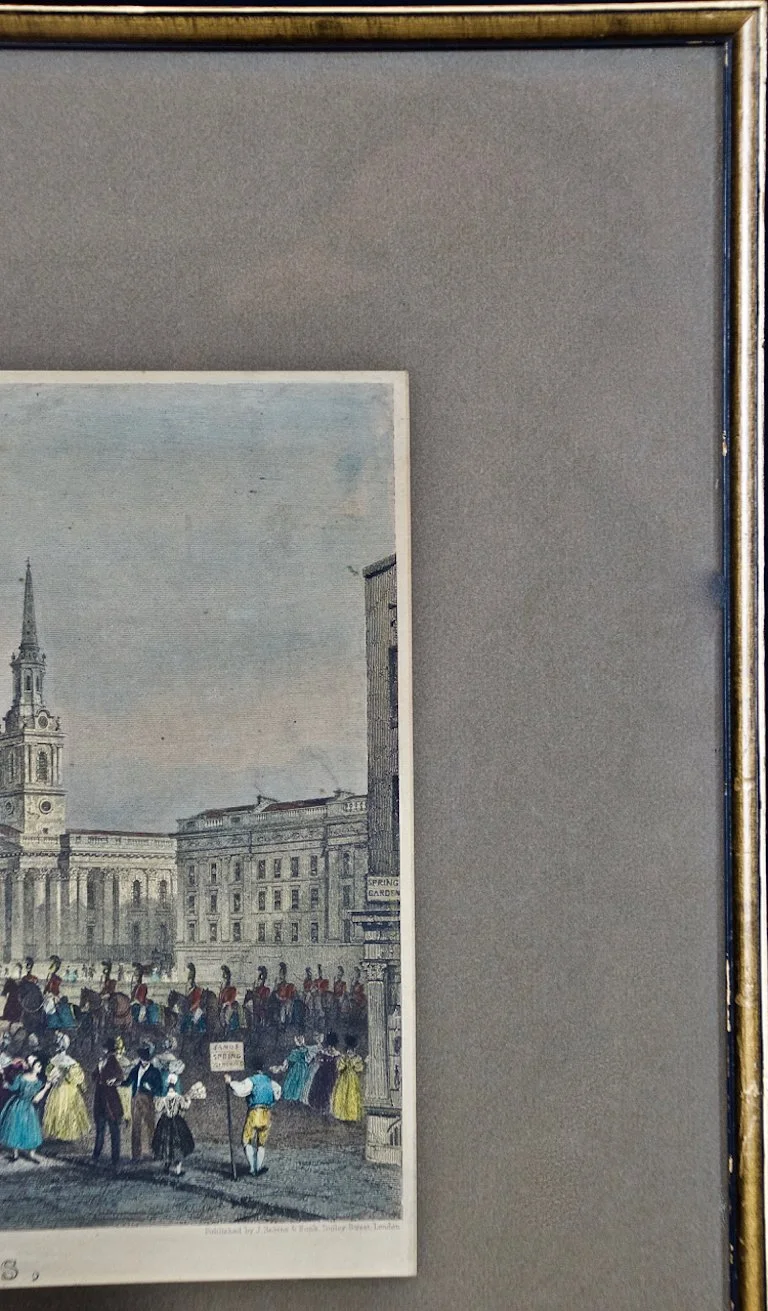Ruins of the Roman Baths of Belisarius: A 19th C. Etching by Luigi Rossini
This early 19th century etching entitled "Veduta degl' Avanzi delle Torri di Belisario Dalla parte che guarda l' Interno della Città, vicino a Porta S. Giovanni, A. Mura Aureliane" (View of the ruins of the Towers of Belisario From the side facing the Interior of the City, near Porta S. Giovanni). It was created by Luigi Rossini and was included in his publication "Le Antichita Romane" (The Rome of Antiquity), published in Rome in 1822. Luigi Rossini's etching depicts the ruins of the ancient Roman monument known as the Baths of Belisarius, located within the city of Rome. The print shows the remains of the monumental arches and columns that once adorned the baths, which were built in the 6th century AD during the reign of the Byzantine emperor Justinian I. In the foreground, a group of figures can be seen standing among the ruins, while in the background, the silhouette of the Colosseum can be seen against the horizon. Rossini's etching is notable for its intricate level of detail and the skillful use of shading and perspective to create a sense of depth and three-dimensionality. The artist was known for his depictions of classical ruins and landscapes, and his work was highly influential in the development of the Romantic movement in art during the early 19th century.
Creator: Luigi Rossini (1790-1857, Italian)
Creation Year: 1822
Dimensions: Height: 27 in (68.58 cm) Width: 31 in (78.74 cm)Depth: 1.5 in (3.81 cm)
Medium: Etching
Condition: See description below.
Reference #: 5074
This early 19th century etching entitled "Veduta degl' Avanzi delle Torri di Belisario Dalla parte che guarda l' Interno della Città, vicino a Porta S. Giovanni, A. Mura Aureliane" (View of the ruins of the Towers of Belisario From the side facing the Interior of the City, near Porta S. Giovanni). It was created by Luigi Rossini and was included in his publication "Le Antichita Romane" (The Rome of Antiquity), published in Rome in 1822. Luigi Rossini's etching depicts the ruins of the ancient Roman monument known as the Baths of Belisarius, located within the city of Rome. The print shows the remains of the monumental arches and columns that once adorned the baths, which were built in the 6th century AD during the reign of the Byzantine emperor Justinian I. In the foreground, a group of figures can be seen standing among the ruins, while in the background, the silhouette of the Colosseum can be seen against the horizon. Rossini's etching is notable for its intricate level of detail and the skillful use of shading and perspective to create a sense of depth and three-dimensionality. The artist was known for his depictions of classical ruins and landscapes, and his work was highly influential in the development of the Romantic movement in art during the early 19th century.
Creator: Luigi Rossini (1790-1857, Italian)
Creation Year: 1822
Dimensions: Height: 27 in (68.58 cm) Width: 31 in (78.74 cm)Depth: 1.5 in (3.81 cm)
Medium: Etching
Condition: See description below.
Reference #: 5074
This early 19th century etching entitled "Veduta degl' Avanzi delle Torri di Belisario Dalla parte che guarda l' Interno della Città, vicino a Porta S. Giovanni, A. Mura Aureliane" (View of the ruins of the Towers of Belisario From the side facing the Interior of the City, near Porta S. Giovanni). It was created by Luigi Rossini and was included in his publication "Le Antichita Romane" (The Rome of Antiquity), published in Rome in 1822. Luigi Rossini's etching depicts the ruins of the ancient Roman monument known as the Baths of Belisarius, located within the city of Rome. The print shows the remains of the monumental arches and columns that once adorned the baths, which were built in the 6th century AD during the reign of the Byzantine emperor Justinian I. In the foreground, a group of figures can be seen standing among the ruins, while in the background, the silhouette of the Colosseum can be seen against the horizon. Rossini's etching is notable for its intricate level of detail and the skillful use of shading and perspective to create a sense of depth and three-dimensionality. The artist was known for his depictions of classical ruins and landscapes, and his work was highly influential in the development of the Romantic movement in art during the early 19th century.
Creator: Luigi Rossini (1790-1857, Italian)
Creation Year: 1822
Dimensions: Height: 27 in (68.58 cm) Width: 31 in (78.74 cm)Depth: 1.5 in (3.81 cm)
Medium: Etching
Condition: See description below.
Reference #: 5074
The etching is presented in an antiqued gold-colored wood frame with a light gray-colored outer mat and a black inner trim mat. The frame measures 27" high, 31" wide and 1.5" deep. There is a subtle, barely perceptible wave to the paper on the right and a tiny spot on the right that may actually represent a small inclusion in the paper occurring during paper manufacture. The etching is otherwise in very good condition.
Luigi Rossini (1790-1857) like his predecessors, Giovanni Piranesi (1720–1778) and Giuseppi Vasi (1710-1782), was an architect and artist. Like Piranesi and Vasi, he wanted to glorify the architecture of ancient Rome, which he felt was deteriorating and needed to be documented. Several of the ruins he illustrated have, in fact, since disappeared leaving only his images as a record of their appearance. His images of the grand edifices of the city dramatically depict the power and glory of ancient Rome reflected by its architecture, but were accurate enough to be used by practicing architects, as well as other serious students of classical antiquity. His art continues to influence and inspire architects, artists and those who love Rome.
Rossini was born in Rome and trained at the Academy of Bologna. Upon graduation, he moved to Rome and attempted a career as an architect. As he was not economically successful as an architect, he became a full-time artist, initially producing souvenirs for local collectors, wealthy and aristocratic European tourists on the Grand Tour, as well as for architectural students and practitioners all over Europe. Many of his prints were published in several imperial folio sized collections, including Le Anchita Romane (The Rome of Antiquity).

